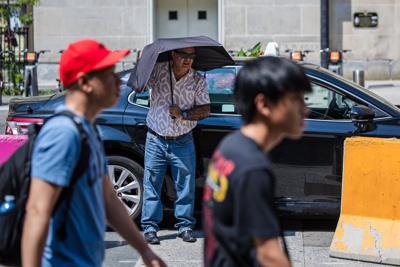Relief from the heat is on its way, ÎÚÑ»´«Ã½.
Environment Canada’s heat warning for the city has been extended until Wednesday evening when peak humidex values are supposed to reach 38, the agency said in . The warning was slated to conclude Tuesday night, with Environment Canada previously saying “confidence has increased” that cooler temperatures are in store for Wednesday.
Here’s what you need to know about the weather in the days ahead.
Environment Canada forecast for ÎÚÑ»´«Ã½
Tuesday is expected to be another sticky one, seeing a high of 31 C that feels like 37 C with humidity. Sunny skies will be paired with a UV index of 9, which is very high.Â
After midnight, clouds expected to roll in, bringing a 30 per cent chance of showers and a possible thunderstorm overnight. Temperatures will cool to a nighttime low of 21 C.
On Wednesday, cloudy skies will stick around with a 40 per cent chance of showers and another possible thunderstorm. A high of 31 C will feel like 38 C with humidity and the UV index will climb to a high of 9. At night, temperatures will dip to 19 C.
Thursday will see blue skies and a high of 25 C, with a clear night dipping to 15 C.
Capping off the week, Friday will see more sunshine with a high of 25 C and nighttime low of 15 C.
ÎÚÑ»´«Ã½ can expect more sunny skies on the weekend. Saturday’s forecast calls for a daytime high of 27 C and nighttime low of 13 C, and Sunday will warm up to 29 C during the day and cool to 15 C at night.
How should I keep cool?
Environment Canada urges people to drink water often — before feeling thirsty. You should also close your blinds or shades and open your windows if it’s cooler outside than it is inside.
Those who can should turn on air conditioning, use a fan or move to a cooler area of your home, Environment Canada added.
If you want to take part in activities, schedule them for the coolest part of the day, Environment Canada said, encouraging people to limit direct sun exposure and to wear light, loose-fitting clothing with a wide-brimmed hat.
Anyone looking for free ways to cool down can also use the of community centres, pools, libraries and other heat relief spaces.
What are the signs of heat-related illness?
Watch out for early signs of heat exhaustion, which include headache, nausea, dizziness, thirst, dark urine and intense fatigue, according to Environment Canada. If you suspect heat exhaustion, stop your activity and drink water, the agency said.
Heat stroke is a medical emergency, signs of which include red and hot skin, dizziness, nausea, confusion and a change in consciousness, the agency added. If you suspect a person might have heat stroke, call for emergency medical attention and try to cool them down.
Extreme heat events mean you should check on older adults, people who live alone and other at-risk people in-person or over the phone multiple times per day, Environment Canada urged.





























To join the conversation set a first and last name in your user profile.
Sign in or register for free to join the Conversation